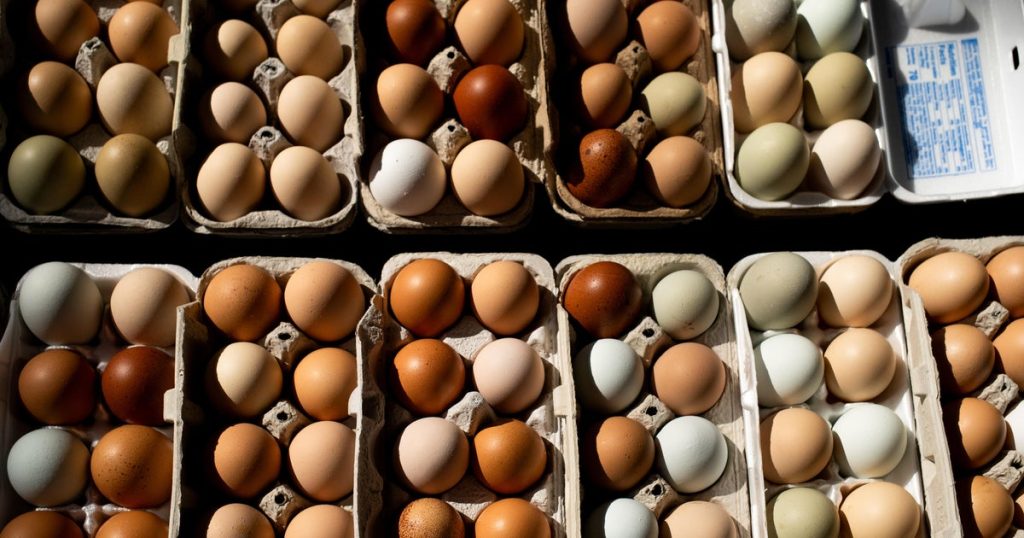Consumers are experiencing relief at the supermarket checkout as egg prices have notably dropped. As of May, the average price for a dozen Grade A large eggs decreased to $4.55, an 11% decline from April’s $5.12, according to the Bureau of Labor Statistics. This downturn is largely attributed to a reduction in avian flu concerns and seasonal fluctuations in egg demand.
| Article Subheadings |
|---|
| 1) Factors Contributing to Price Drops |
| 2) Price Comparisons Over Time |
| 3) Continuing Challenges from Avian Flu |
| 4) Consumer Reactions to Egg Prices |
| 5) Predictions for Future Pricing |
Factors Contributing to Price Drops
A significant factor contributing to the decrease in egg prices has been the diminishing effects of a prolonged avian flu outbreak. Experts assert that the easing of concerns surrounding the flu, combined with seasonal changes in consumer behavior, has led to falling demand. Brett House, an economics professor at Columbia Business School, attributed this price drop primarily to two factors: the reduction in discussion about bird flu and seasonal shifts in egg consumption. He stated,
“People aren’t making heavy breakfasts, so we don’t see demand for eggs being as strong as it typically is during the winter months.”
As summer approaches, consumers tend to favor grilling and meat consumption, leading to a natural decline in egg demand.
Price Comparisons Over Time
Despite the recent price drop, current egg prices remain elevated compared to the same period last year. As per statistics, a dozen eggs in May 2024 was priced at $2.70, showcasing how prices have surged over the past year. The decline from a high of $6.23 per dozen in March signals positive trends, but ongoing price monitoring is essential. David Ortega, a food economics professor at Michigan State University, noted that while wholesale egg prices started to fall in March, retail prices typically lag behind by a few months. He observed,
“There’s a bit of a lag before they reach consumers at the grocery store.”
Even though the situation appears to be improving, the noticeable price increase over the year continues to impact consumer spending and budgeting.
Continuing Challenges from Avian Flu
While there are signs of recovery in egg pricing, the battle against avian flu is far from over. As recently as May, a new outbreak at a layer farm in Arizona affected approximately 1.4 million birds, emphasizing that the threat is ongoing. Ortega cautioned that, despite recent price reductions, the avian flu continues to have ramifications on the egg supply chain. He remarked,
“It’s still very much an issue.”
This highlights that while current trends may suggest a normalization of prices, external factors like disease outbreaks can lead to sudden fluctuations in egg availability and pricing.
Consumer Reactions to Egg Prices
Consumers have expressed a mix of relief and caution regarding the current price drops. Many shoppers have been historically affected by soaring costs, leading to changes in purchasing behavior. With inflation being a persistent concern, the recent decrease in egg prices comes as a boon for budget-conscious individuals and families. Surveys conducted in recent days reveal that some consumers are still hesitant to fully return to pre-pandemic purchasing habits. Many have reduced their consumption of eggs and are exploring alternative proteins in meals. This shift demonstrates how dramatically food pricing influences consumer decision-making and purchasing strategies.
Predictions for Future Pricing
Economic analysts are projecting that while egg prices may continue to see fluctuations, the upcoming months could potentially stabilize prices. Seasonal demand typically eases into summer, and this trend could help to maintain a steady pricing structure in the near term. Experts believe that if avian flu outbreaks can be controlled, there may be a more significant and sustained reduction in prices. However, as Ortega cautioned, it’s important to remain vigilant. He pointed out that if new outbreaks occur, they could led to immediate price surges that would impact consumer behavior further.
| No. | Key Points |
|---|---|
| 1 | Egg prices decreased to $4.55 per dozen in May, down from $5.12 in April. |
| 2 | Demand for eggs typically softens during the summer months. |
| 3 | Current egg prices are still significantly higher than last year’s prices. |
| 4 | An outbreak in May affected 1.4 million birds in Arizona, indicating ongoing avian flu concerns. |
| 5 | Experts suggest that future pricing may stabilize if avian flu outbreaks are contained. |
Summary
The recent decline in egg prices signifies a moment of relief for consumers facing inflationary pressures. As the industry grapples with the lasting effects of avian flu and changing consumer demand, it is crucial to monitor ongoing developments. While there are signs of improved conditions, experts warn that the situation can change rapidly. Maintaining an informed perspective on pricing trends will be essential for consumers and producers alike.
Frequently Asked Questions
Question: What factors are driving the drop in egg prices?
The primary drivers include a decrease in avian flu concerns and seasonal shifts in consumer demand, especially as summer approaches.
Question: How do current egg prices compare to last year?
Currently, egg prices are significantly higher compared to the same period last year, with a dozen eggs costing $4.55 this May versus $2.70 in May 2024.
Question: Are avian flu outbreaks still a concern for the egg industry?
Yes, avian flu remains a concern, evidenced by recent outbreaks affecting millions of birds, which could impact supply chains and egg prices.


